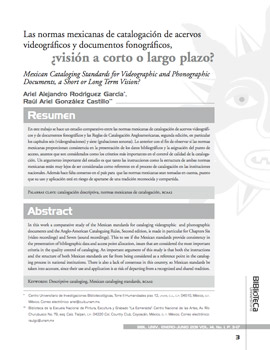Mexican Cataloging Standards for Videographic and Phonographic Documents, a Short or Long Term Vision?
DOI:
https://doi.org/10.22201/dgb.0187750xp.2011.1.119Keywords:
Descriptive cataloging, Mexican cataloging standards, rcaa2Abstract
In this work a comparative study of the Mexican standards for cataloging videographic and phonographic documents and the Anglo-American Cataloguing Rules, Second edition, is made in particular for Chapters Six (video recordings) and Seven (sound recordings). This to see if the Mexican standards provide consistency in the presentation of bibliographic data and access point allocation, issues that are considered the most important criteria in the quality control of cataloging. An important argument of this study is that both the instructions and the structure of both Mexican standards are far from being considered as a reference point in the catalog- ing process in national institutions. There is also a lack of consensus in this country, so Mexican standards be taken into account, since their use and application is at risk of departing from a recognized and shared tradition.Downloads
References
Anderson, Rick. Being Essential is not Enough, Part 2. Library Journal Academic Newswire, September 2, 2014.
De Bono, Caspar, Arnold, Kate. The Evolving Value of Information Management. London: Financial Times: Special
Libraries Association, 2013. 34 p. DOI: https://doi.org/10.5596/c13-055
Edgar, Sue. Is the Bell Tolling for the Death of the Corporate Information Unit? Business Information Review, Sept- ember 2009, vol. 26, no. 3, p. 201-204. DOI: https://doi.org/10.1177/0266382109341320
Jester, Roger E. To the Ends of the Earth: Librarians and Management Information Needs, Special Libraries, Summer 1992, v. 83, no.3.
Matarazzo, James M. Closing the Corporate Library: Case studies on the decision-making process. New York: Special Libraries Association, 1982. 154 p.
Matarazzo, James M., Pearlstein, Toby. Corporate Libraries: A Confluence of Forces Pressing on their Future. Journal of Library and Information Sciences, March 2014, vol. 2, no.1.
----------. Corporate Score, Library Journal, February 1, 2007, vol. 132.
----------. Special Libraries: A Survival Guide. Santa Barbara, ca. abc-Clio, 2013. 167 p.
Matarazzo, James M., Prusak, Laurence. The Value of Corporate Libraries: Findings from a 1995 Survey of Senior Management. Washington, d.c.: Special Libraries Association, 1995. 21 p.
Matarazzo, James M., Prusak, Laurence, Gauthier, Michael R. Valuing Corporate Libraries: A Senior Management Survey. Washington, d.c.: Special Libraries Association, 1990. 11 p.
Prusak, Laurence, Matarazzo, James M. Information Management and Japanese Success. Washington, d.c.: Special Libraries Association, 1992.
Prusak, Laurence, Davenport, Thomas H. Blow Up the Corporate Library. International Journal of Information Management, 1993, vol. 13, no 6, p. 405-412. DOI: https://doi.org/10.1016/0268-4012(93)90057-B
Rigby, Darrell, Bilodeau, Barbara. Management Tools & Trends. Boston: Bain & Company, 2013. 14 p.

Downloads
Published
How to Cite
Issue
Section
License
Descargar el formato de Cesión de derechos en formato PDF:
Formato de Cesión de derechos
Imprímalo y una vez que lo haya firmado envíenoslo vía fax o por correo a:
Revista Biblioteca Universitaria:
Dirección General de Bibliotecas y Servicios Digitales de Información de la UNAM
Departamento de Publicaciones
Edificio de la Biblioteca Central, 11o Piso,
Circuito Interior, Ciudad Universitaria, 04510 México, D.F.
Tel 5622-1616,
Fax: 5622-1601,






